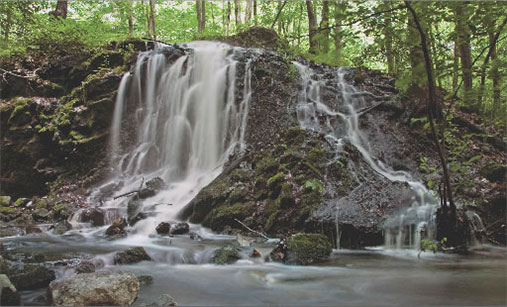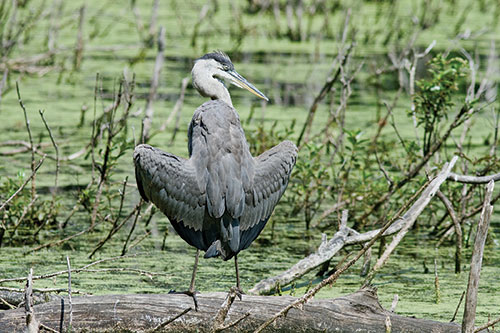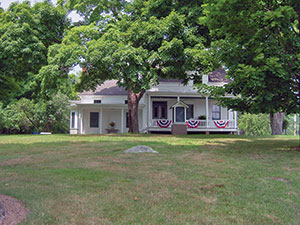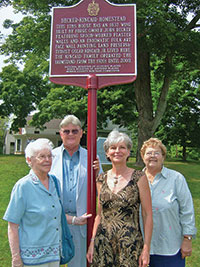Viewed from an Adirondack chair on the south shore of Deer Lake, the scene stuns with unspoiled simplicity. Across still water, dense forest rises uninterrupted, its reflection spreading below. The view looks much as it must have in 1935, when area businessmen founded a rustic private retreat called Deer Lake Club in the modest Stony Brook Mountains. At the time, these gentlemen stood embedded in countryside, surrounded by miles and miles of farms and undeveloped land. They opened their property, outfitted with a timbered clubhouse, to no one but members. Their lake, tapped at both ends by Stony Brook, provided a haven for boaters, swimmers, sportsmen and families, protected, in their view, by stringent membership protocols and wooded buffers on all sides.

For decades, intensely private Deer Lake Club, tucked out of sight and marked only by a small, easily overlooked iron sign, remained secure. But the largely undeveloped terrain that framed it, as the last century came to a close, did not. Standing barely eight miles from the intersection of Routes 287 and 80, scarcely thirty miles from Manhattan, and smack in the middle of some of the country’s priciest real estate, how could it?
There begins the story of one of the Northwestern New Jersey’s largest and more improbable natural treasures, a fist shaped swath of land designated in 1987 as the Pyramid Mountain Natural Historic Area, nearly 1,500 acres of wooded terrain dotted with brooks, swamps, glacial deposits, rock outcroppings glens and vistas.
Today, the territory, which still beckons beyond the shores of private Deer Lake is wide open to the public: to hikers, snowshoers, bird watchers, geology buffs, dog walkers (on leash) and hunters (with restrictions). Defying the odds, while certain neighboring hills and fields have given way to sub-divisions and roadways, the mountains and wetlands that rise and fall in this corner of the Passaic River Watershed stand largely unspoiled. On either side of Stony Brook, which leads through Deer Lake into the Pyramid Mountain Area and onto the picturesque Taylortown Reservoir, nature remains intact. Overseen by the Morris County Park Commission, it overlaps parts of Kinnelon, Montville Township, and Boonton Township.
For years, this property, part of what was once known as the Great Boonton Tract, some of it surveyed by William Penn, remained an open secret. In the 1800s legend has it, Boonton outlaws (or just plain troublem akers) called the Morgan brothers hid out/hung there. The “Ruins of the Morgan Place”, stone remnants of their cabin, linger by a trail on the western side of the park. But after the Morgans, the mountains and valleys became favored among hunters, adventurous hikers, and youthful trespassers. The area attracted them not only with its collection of massive boulders, but also with natural beauty, seclusion, and a hint of magic. To the north, hikers could climb to an impressive landmark of mysterious though disputed origins: Tripod Rock, one of the state’s largest erratics, a mega-boulder balancing atop much smaller rocks on Pyramid Mountain. (While some believe early Indian inhabitants assembled it as a solstice oriented worship site, others simply credit a powerful glacier). Heading southeast to the northern side of Lake Valhalla in Montville, lay The Glen, a sloped verdant aerie appreciated for its mystical, filtered light. Local “hippies” were known to congregate there in the 1960s.
A patchwork of acreage held in many different hands over time, by the mid twentieth century the area had already experienced two significant disturbances, separated by about 18,000 years; one natural, the other man-made. First, the Ice Age, during which the Wisconsin Glacier raked its way across the region, churning, dragging and spitting out gravel, sand and clay, deposits large enough to form Long Island. Incidentally, Tripod Rock, which weighs in at close to 160 tons, plus its companions, Whale Head and Bear Rock, the largest of the three, were stranded, part of the terminal moraine that stretches across Northern New Jersey.
Then, America’s Electrification Age in the 1920s, when high towers strung with electrical lines pierced the northwest corner (the ambitious national effort resulted in roughly 70% of households having electricity by the 1930s). After that, the landscape more or less stood still.
It was Kinnelon resident Lucy Meyer who mustered passionate forces to fight off the next interloper: encroaching development. In the 1980s, she, together with her husband Karl, ardent hikers, organized a grassroots campaign that rallied support to preserve the Pyramid Mountain area. Founding The Committee To Preserve Pyramid Mountain, Meyer ultimately succeeded in putting the property in public hands by knitting together municipal, county and state resources to purchase it. Honored with a Pride In America award by President Ronald Reagan for her efforts, Meyer was also memorialized with Lucy’s Overlook, a scenic lookout at an 841 foot elevation, south of Tripod Rock, with a long view of the mountains she loved.
Jeff Tittel, president of the New Jersey chapter of the Sierra Club, affirms that the Pyramid Mountain’s open space stands out, not only in the Garden State, but nationally. “We look at the Northern part of the Highlands as one of the most important areas environmentally in the country,” says Tittel, who calls Pyramid Mountain “a gem of the region.” Its particular geography, he points out, makes it home to an especially wide range of wildlife. “It is the northernmost range for southern species and the southernmost range for northern species,” he explains. The terrain harbors an estimated four-hundred types of native plants and is crisscrossed by thirty types of mammals and one-hundred varieties of birds and myriad butterflies. Black bear, coyote, and deer make regular appearances, and bobcat, though elusive, also are thought to roam, having lent their name long ago to favorite haunts and hideaways, including Little Cat Swamp, Big Cat Swamp and Cat Rocks. Wild turkey, poking along in ground hugging packs, woodpeckers, red tailed hawks, and owl abound.

In spite of vigorous opposition, lines for the Susquehanna-Roseland Reliability project now cross through four miles of the Delaware Water Gap National Recreation Area and Sussex County, before snaking through Morris and across Pyramid Mountain land from the western side of the park. PSE&G spokesman George D. Sous points out that power lines have crossed the property since the 1920s, before any trails or park designation existed and that the company has attempted to minimize the project’s impact, opting for helicopter installation to prevent heavy overland truck and worker traffic. “It’s never been about zero impact, it’s about the least amount of new impact,” notes Sous, Manager of State Transmission Outreach and Strategy, addressing concerns about the appearance and environmental footprint of the towers. “We all need and want things like cellular and water service, but we don’t like looking at the necessary infrastructure.”

The construction crews and heavy equipment have gone, and the Park Commission has reopened the Area’s wide variety of trails, whose loops and climbs feature landmarks as well as mountain and city views. Generally moderate, the terrain still requires sturdy footwear. Some paths border on difficult; there are occasional rock scrambles, steep spots, wet swampy sections and a series of one hundred rock steps. Hikers can once again approach the park either from the west at the Kincaid Woods Access area on Powerville Road in Boonton Township, or the east from the Boonton Avenue Visitors Center in Montville. The Kincaid Woods access offers more parking, but the Visitors Center, staffed by naturalists, stands squarely in the center of the park, closer to Pyramid and Turkey Mountains and provides exhibits on the Area’s natural and human history as well as information on upcoming events.


Visitors arriving at Pyramid Mountain on its western side, by Kincaid Woods in Boonton Township, can have a look at one of the Township’s oldest homes, the Oscar Kincaid House of History, now a house museum. (The last phase of restoration of the site, which is on the National Register of Historic Places, begins this spring.) Settlers built the original structure in 1785, with subsequent residents adding on in 1837 and 1850. In front of the house stands a structure said to be one of the oldest continuously operated farm stands in the area, from which Oscar Kincaid, who died in 2000, sold treats and ice cream to passersby and neighbors in the 1920s. Oddly, the house, which stands in the shadow of mysterious Pyramid Mountain, presents a mystery of its own, but one far more delicate than that of Tripod Rock. Someone—it is not known who—painted an unusual and unexplained piece of folk art, an eerie, other-worldly face, on a wall of the front hall. The Historical Society of Boonton Township, which has preserved the house, commissioned Anton “Tony” Rajer, nationally known folk art conservationist, to restore the wall art. Historians know little about “The Famous Face,” other than its age: 175 years – far younger than its ancient rival across the street.
The Pyramid Mountain Visitor Center is located the southeast corner of the park, accessible from Boonton Avenue (Route 511).
The Millstone Scenic Byway includes eight historic districts along the D&R Canal, an oasis of preserved land, outdoor recreation areas in southern Somerset County
Part of the Morristown National Historic Park, the formal walled garden, 200-foot wisteria-covered pergola, mountain laurel allee and North American perennials garden was designed by local landscape architect Clarence Fowler.
Paths of green, fields of gold!
The Jacobus Vanderveer house is the only surviving building associated with the Pluckemin encampment.
Dedicated to preserving the heritage and history of the railroads of New Jersey through the restoration, preservation, interpretation and operation of historic railroad equipment and artifacts, the museum is open Sundays, April thru October.